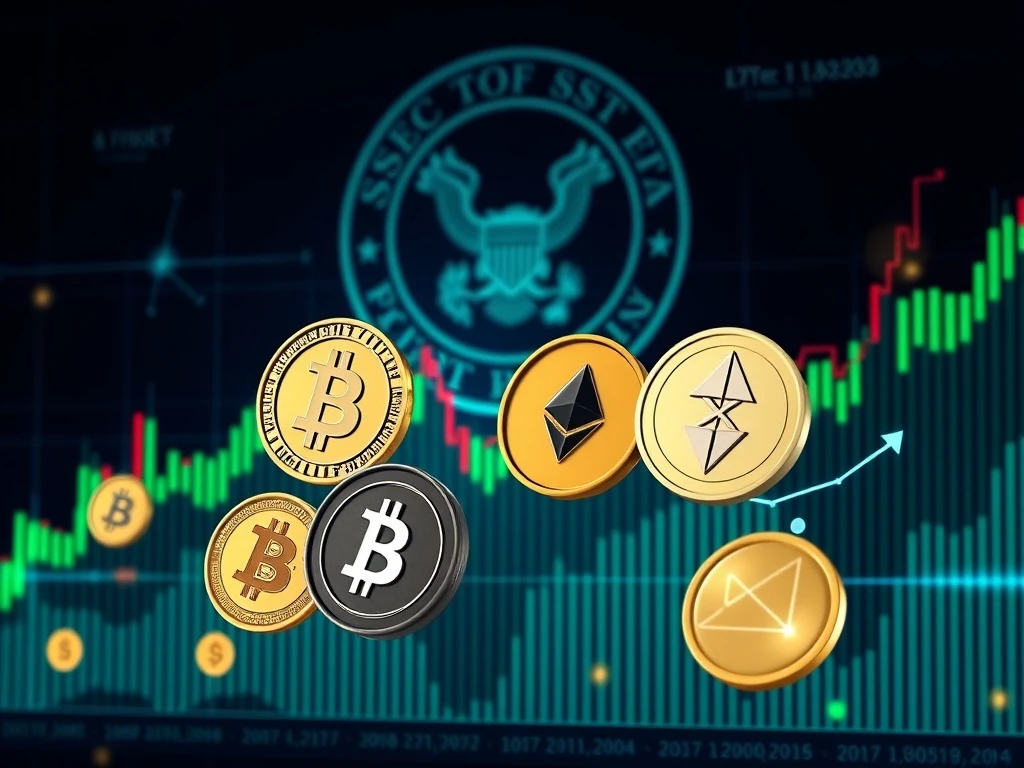Unlocking Potential: Hashdex ETF Expands with XRP, SOL, and XLM

The cryptocurrency investment landscape is undergoing a significant transformation. Investors now seek diversified exposure to digital assets. Consequently, the expansion of the Hashdex ETF marks a pivotal moment. This development follows recent regulatory changes. It also opens new avenues for market participation.
Hashdex ETF Expands Horizon with New Crypto Assets
Asset manager Hashdex recently expanded its Crypto Index US ETF. This fund now includes XRP (XRP), Solana (SOL), and Stellar (XLM). This move follows a crucial rule change from the Securities and Exchange Commission (SEC). The Nasdaq-listed ETF, trading under the ticker NCIQ, now holds five cryptocurrencies. Bitcoin (BTC) and Ether (ETH) were already part of its portfolio. Each asset is held on a 1:1 basis by the fund. This expansion makes it the second multi-asset cryptocurrency investment vehicle approved for trading in the United States. Therefore, it offers broader exposure to the digital asset market.
This strategic addition demonstrates Hashdex’s commitment to diversified crypto offerings. Furthermore, it reflects a growing institutional interest in a wider range of digital assets beyond just Bitcoin and Ethereum. The inclusion of XRP SOL XLM directly responds to market demand. It also aligns with evolving regulatory clarity. This development signifies increasing maturity within the crypto investment sector.
Understanding SEC Generic Listing Standards
The SEC approved new SEC generic listing standards for ETFs in September. This action streamlines the approval process for eligible cryptocurrencies. Previously, each ETF application faced a lengthy individual review. Now, certain criteria allow for faster approvals. This change marks a significant shift in the regulatory approach to digital asset products. Consequently, it paves the way for greater innovation in the market.
To qualify for generic listing eligibility, a cryptocurrency must meet specific requirements:
- It must be classified as a commodity.
- Alternatively, it must feature futures contracts listed on reputable exchanges.
- Additionally, eligible cryptos must undergo financial surveillance. This surveillance operates under the US Intermarket Surveillance Group.
These standards ensure a degree of market integrity and oversight. Market analysts anticipate a surge in new crypto ETF filings. This is a direct result of these new standards. Such developments will give stock market participants easier access to crypto markets. Furthermore, they will blur the lines between traditional financial instruments and digital assets. Source: SEC
The Rise of Multi-Asset Crypto ETFs
The approval of generic listing standards directly impacts the proliferation of multi-asset crypto ETF products. On September 17, the SEC approved the Grayscale Digital Large Cap Fund. This fund became the first US multi-asset crypto ETF. Grayscale’s fund includes Bitcoin (BTC), Ether (ETH), XRP (XRP), Solana (SOL), and Cardano (ADA). These early approvals indicate a clear trend. Investment vehicles are moving towards diversified crypto exposure. Investors can now access a basket of digital assets through traditional brokerage accounts. This simplifies the investment process considerably. Moreover, it reduces some of the complexities associated with direct crypto purchases.
This trend signifies a maturation of the crypto market. It moves beyond single-asset exposure. Fund managers are actively creating products that mirror broader market indices. This approach offers balanced risk and return profiles. Consequently, it appeals to a wider range of investors. These investors might seek diversified exposure to the digital economy. The competitive landscape for crypto ETFs is also heating up. More options will likely emerge, offering varied asset allocations and strategies.
Regulatory Shift: Paul Atkins and the Innovation Exemption
SEC Chair Paul Atkins is actively spearheading efforts to modernize the financial system. This includes streamlining the ETF approval process for cryptocurrencies. His initiatives are part of a broader push for digital finance. Atkins recently proposed an “innovation exemption” for crypto companies. This regulatory sandbox would allow crypto projects to experiment. They could test new technologies without immediate fear of regulatory reprisal. This approach fosters innovation. It also provides a structured environment for growth. Source: Eric Balchunas
The SEC, under President Donald Trump’s administration, has pursued new policies in 2025. These policies aim to reduce the regulatory burden on crypto companies. This marks a significant departure from the SEC under former Chair Gary Gensler. Key policy shifts include:
- Ending regulation by enforcement, which previously involved lawsuits without due notice.
- Crafting comprehensive market structure rules for digital assets.
- Classifying most cryptocurrencies as commodities. This classification benefits assets like XRP SOL XLM.
These changes aim to provide clarity and stability. They encourage legitimate development within the digital asset space. This proactive regulatory stance supports the growth of new investment products. It also bolsters confidence among institutional players.
Broader Implications for Digital Finance
The expansion of the Hashdex Crypto Index US ETF and the SEC’s evolving stance carry broad implications. They signify a crucial step towards mainstream adoption of digital assets. Traditional financial instruments and digital assets are increasingly blurring. This convergence offers new opportunities. It also presents new challenges for regulators and market participants alike. Increased accessibility through ETFs will undoubtedly attract more capital. It will also bring more traditional investors into the crypto ecosystem.
These developments contribute to a more robust and regulated digital asset market. They provide clearer pathways for institutional engagement. Ultimately, this fosters greater trust and stability. The ongoing evolution of regulatory frameworks is vital. It ensures that innovation can thrive responsibly. This also protects investors. The future of finance will undoubtedly be shaped by these converging forces.








